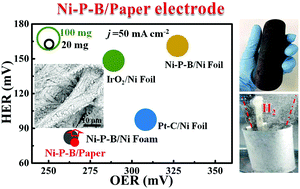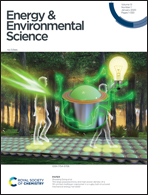Fabrication of practical catalytic electrodes using insulating and eco-friendly substrates for overall water splitting†
Abstract
The development of efficient and cost-effective catalytic electrodes is of great importance to electrolysis. Herein, a strategy of fabricating practical catalytic electrodes by depositing conductive catalysts on inexpensive and easily accessible insulating substrates of paper, textiles and sponge has been realized and well developed. These electrodes are found to be highly active toward overall water splitting. As a distinctive example, the Ni–P–B/paper electrode affords 50 mA cm−2 at overpotentials of only 76 mV for the hydrogen evolution reaction and 263 mV for the oxygen evolution reaction, and can survive at large current density of 1000 mA cm−2 for over 240 h without apparent performance degradation in 1.0 M KOH. A two-electrode cell constructed by this paper electrode, which is only 1/5 the weight of a traditional metal electrode, delivered 50 mA cm−2 water-splitting current at a cell voltage of only 1.661 V, rivalling the integrated state-of-the-art Pt–C/Ni and IrO2/Ni electrode. Moreover, a functional Ni–P–B/paper ring electrode with in situ separation function has been constructed, enabling simultaneous generation, separation and collection of hydrogen and oxygen. This discovery may enable a large extension toward practical catalytic electrodes that are also active, cheap, light, flexible, earth-abundant and recyclable.



 Please wait while we load your content...
Please wait while we load your content...